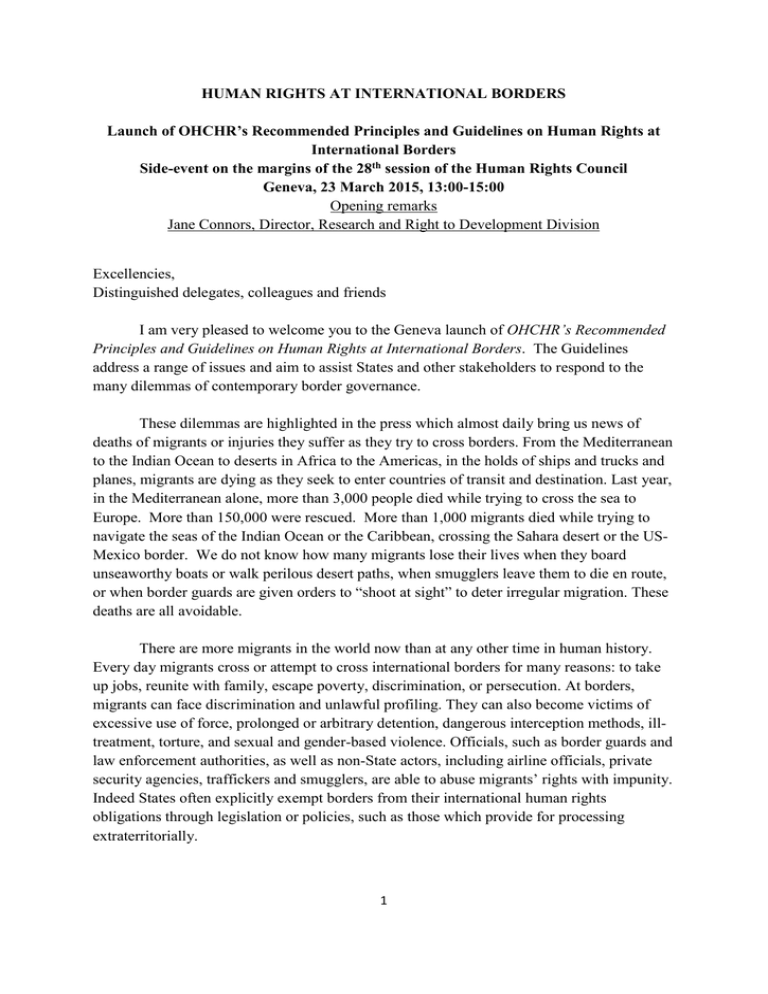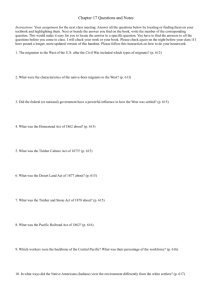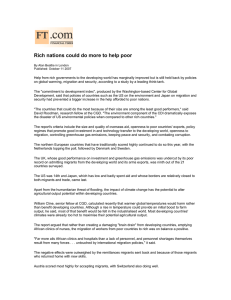HUMAN RIGHTS AT INTERNATIONAL BORDERS
advertisement

HUMAN RIGHTS AT INTERNATIONAL BORDERS Launch of OHCHR’s Recommended Principles and Guidelines on Human Rights at International Borders Side-event on the margins of the 28th session of the Human Rights Council Geneva, 23 March 2015, 13:00-15:00 Opening remarks Jane Connors, Director, Research and Right to Development Division Excellencies, Distinguished delegates, colleagues and friends I am very pleased to welcome you to the Geneva launch of OHCHR’s Recommended Principles and Guidelines on Human Rights at International Borders. The Guidelines address a range of issues and aim to assist States and other stakeholders to respond to the many dilemmas of contemporary border governance. These dilemmas are highlighted in the press which almost daily bring us news of deaths of migrants or injuries they suffer as they try to cross borders. From the Mediterranean to the Indian Ocean to deserts in Africa to the Americas, in the holds of ships and trucks and planes, migrants are dying as they seek to enter countries of transit and destination. Last year, in the Mediterranean alone, more than 3,000 people died while trying to cross the sea to Europe. More than 150,000 were rescued. More than 1,000 migrants died while trying to navigate the seas of the Indian Ocean or the Caribbean, crossing the Sahara desert or the USMexico border. We do not know how many migrants lose their lives when they board unseaworthy boats or walk perilous desert paths, when smugglers leave them to die en route, or when border guards are given orders to “shoot at sight” to deter irregular migration. These deaths are all avoidable. There are more migrants in the world now than at any other time in human history. Every day migrants cross or attempt to cross international borders for many reasons: to take up jobs, reunite with family, escape poverty, discrimination, or persecution. At borders, migrants can face discrimination and unlawful profiling. They can also become victims of excessive use of force, prolonged or arbitrary detention, dangerous interception methods, illtreatment, torture, and sexual and gender-based violence. Officials, such as border guards and law enforcement authorities, as well as non-State actors, including airline officials, private security agencies, traffickers and smugglers, are able to abuse migrants’ rights with impunity. Indeed States often explicitly exempt borders from their international human rights obligations through legislation or policies, such as those which provide for processing extraterritorially. 1 OHCHR’s Principles and Guidelines on Human Rights at International Borders are the result of a wide-ranging process of expert consultation and were made available to the 69th session of the General Assembly in New York last October. They respond to a clear need today for practical, rights-based policy guidance on the issue of human rights at borders. We have been gratified to see that they have been welcomed by States, and highlighted in the General Assembly’s resolutions on Protection of Migrants and Migrant children and adolescents. They were discussed during the last Global Forum on Migration and Development. We have also been pleased to see that civil society is beginning to use the Guidelines in their practical work. You will hear more about this today. The Principles and Guidelines are underpinned by three guiding principles: the primacy of human rights law; the principle of non-discrimination; and assistance and protection from harm. While recognizing that States have legitimate interests when they exercise immigration controls, the document notes that they must respect, protect and fulfil the human rights of migrants at borders, without discrimination of any kind. One of the key premises of the Principles and Guidelines is that respecting the human rights of all migrants facilitates, rather than hinders, the effective governance of borders. The ten Guidelines then provide a wealth of practical human rights-based border governance measures. In Guideline 1, States are asked to improve knowledge and address negative perceptions of migrants, including through the media, and to ensure that the term “illegal” is not used to refer to migrants in an irregular situation. On the legal and policy framework, Guideline 2 notes that relevant domestic legislation needs to be brought in line with international human rights standards. This means ensuring that provisions of non-discrimination, mandatory protection and assistance, noncriminalization of migrants, accountability, and access to justice and redress, are enshrined in national legislation. As global mobility patterns become more complex, the role of border authorities and the challenges they face multiply. Adequately trained personnel and resources are essential so that mandated tasks can be performed in accordance with international standards, as highlighted in Guideline 3. Here States are asked to develop and adopt binding codes of conduct for border authorities. Guideline 4 contains practical guidance on rescue and interception. Rescue operations should be implemented in such a way as to ensure the enjoyment by all persons at 2 risk of human rights, safety and dignity. Avoiding imminent danger to lives and ensuring safety should be the first priority for border authorities and those in control of private ships. It recommends practical measures such as providing rescue beacons along dangerous migration routes, and compensating shipmasters who incur financial losses for rescuing migrants. In the context of immediate assistance, Guideline 5 makes clear that at all places of rescue, interception or disembarkation, immediate assistance should be provided where necessary. This should include medical care, provision of adequate food and water, blankets, clothing, and sanitary items. It calls on States to ensure that all migrants receive necessary medical attention including mental health referrals where appropriate. Guideline 6 calls for human rights-based approaches to screening and interviewing. Each person who approaches a border is entitled to an individual determination of her reasons for entry and defence against expulsion. The Guideline asks States to avoid including compulsory testing for conditions such as HIV, tuberculosis and pregnancy in migration policy. Guideline 7 notes that border authorities should be able to identify and refer migrants who may be at risk rapidly. This is particularly important for children, pregnant or breastfeeding women or victims of violence and trauma, including sexual or gender-based violence. It is also essential that service providers, such as interpreters, legal aid and health professionals, are present at international borders. Some countries systematically detain migrants at borders. Guideline 8 notes that a presumption against detention should be established in law and human rights-compliant alternatives to detention should be sought in the first instance. Children should never be detained on the basis of their or their parents’ migration status. Guideline 9 states that any decisions to remove or return migrants should be carried out in accordance with international law and with due procedural guarantees, including upholding the principle of non-refoulement and the prohibition of collective expulsion. This Guideline notes in particular that any consent given to voluntary return processes should be free of any coercion, such as the threat or the prospect of indefinite detention. Finally, Guideline 10 calls for robust bilateral, regional and international cooperation in order to promote human rights-based, equitable, dignified, lawful and evidence-based migration and border governance measures. This Guideline urges States to include explicit human rights guarantees in operational agreements and arrangements and immediately suspend any border cooperation arrangements, such as joint patrols or data-sharing agreements that are not in accordance with international human rights law and standards. Colleagues and friends, 3 Many migrants experience horrific human rights violations at international borders. Indeed, borders can be very dangerous places for migrants to be, particularly if they are (or presumed to be) in irregular situations. We hope that the Principles and Guidelines will assist States and others to put human rights obligations and principles at the centre of their border governance efforts and, in so doing protect and promote the human rights of all migrants who arrive at international borders. We stand are happy to engage with Member States, UN agencies, human rights mechanisms, civil society organizations and private actors to support their efforts to implement the Principles and Guidelines. I encourage all of you to use them in your work. Thank you for your attention. 4



